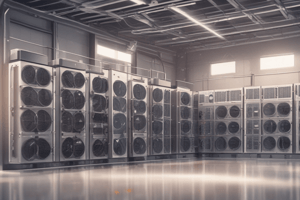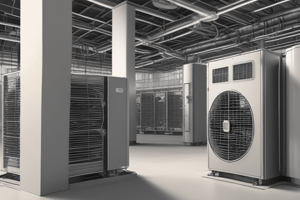Podcast
Questions and Answers
What is the main function of an air conditioning plant?
What is the main function of an air conditioning plant?
- Transferring energy from the conditioned space (correct)
- Acting as a heat source in summer systems
- Supplying latent heat to the space in winter
- Acting as a heat sink in winter systems
Why is a thermal distribution system necessary in an air conditioning system?
Why is a thermal distribution system necessary in an air conditioning system?
- To act as a heat source
- To increase energy consumption
- To introduce fresh air into the conditioned space (correct)
- To reduce Indoor Air Quality (IAQ)
Which factor does NOT influence the selection of an air conditioning system?
Which factor does NOT influence the selection of an air conditioning system?
- Type of refrigerant used (correct)
- Required system reliability and flexibility
- Initial and running costs
- Maintainability
In summer systems, what role does the air conditioning plant play?
In summer systems, what role does the air conditioning plant play?
What type of heat has to be supplied to the space in winter?
What type of heat has to be supplied to the space in winter?
Apart from energy transfer, what is another important function of the thermal distribution system?
Apart from energy transfer, what is another important function of the thermal distribution system?
What is the advantage of variable air volume (VAV) systems over constant volume systems?
What is the advantage of variable air volume (VAV) systems over constant volume systems?
Why can there be problems with ventilation and indoor air quality in very low load situations in variable air volume systems?
Why can there be problems with ventilation and indoor air quality in very low load situations in variable air volume systems?
What is a potential difficulty in balancing dampers in variable air volume systems?
What is a potential difficulty in balancing dampers in variable air volume systems?
How do dual duct, constant volume systems provide both cooling and heating to different zones?
How do dual duct, constant volume systems provide both cooling and heating to different zones?
Why does the dual duct system occupy more space compared to other systems?
Why does the dual duct system occupy more space compared to other systems?
What allows dual duct systems to maintain proper indoor air quality and room air distribution?
What allows dual duct systems to maintain proper indoor air quality and room air distribution?
In outdoor air control in all air systems, why are the exhaust and outdoor air dampers controlled in unison?
In outdoor air control in all air systems, why are the exhaust and outdoor air dampers controlled in unison?
How can energy efficiency be improved in dual duct systems during cold weather?
How can energy efficiency be improved in dual duct systems during cold weather?
What is the main difference between dual duct, constant volume systems and dual duct, variable air volume systems?
What is the main difference between dual duct, constant volume systems and dual duct, variable air volume systems?
In single duct systems, what is the function of the supply fan?
In single duct systems, what is the function of the supply fan?
What is the primary purpose of a humidistat in single zone air conditioning systems?
What is the primary purpose of a humidistat in single zone air conditioning systems?
What differentiates dual duct systems from single duct systems in air conditioning?
What differentiates dual duct systems from single duct systems in air conditioning?
What distinguishes single zone systems from multiple zone systems in air conditioning?
What distinguishes single zone systems from multiple zone systems in air conditioning?
What is a characteristic feature of constant volume air conditioning systems?
What is a characteristic feature of constant volume air conditioning systems?
What happens to return air from the conditioned space in all air systems?
What happens to return air from the conditioned space in all air systems?
How does an all water system differ from an all air system in air conditioning classification?
How does an all water system differ from an all air system in air conditioning classification?
'Dual duct variable volume systems' are distinguished by their ability to:
'Dual duct variable volume systems' are distinguished by their ability to:
What is a defining characteristic of unitary refrigerant-based systems in air conditioning classification?
What is a defining characteristic of unitary refrigerant-based systems in air conditioning classification?
What differentiates 'constant volume, multiple zone systems' from 'variable volume systems'?
What differentiates 'constant volume, multiple zone systems' from 'variable volume systems'?
What percentage of supply air flow rate is typically required for ventilation in the described system?
What percentage of supply air flow rate is typically required for ventilation in the described system?
In what temperature range is it recommended to use 100% outdoor air in the air conditioning system?
In what temperature range is it recommended to use 100% outdoor air in the air conditioning system?
What is a disadvantage of all air systems mentioned in the text?
What is a disadvantage of all air systems mentioned in the text?
What type of buildings may find it difficult to provide air conditioning using all air systems due to space constraints?
What type of buildings may find it difficult to provide air conditioning using all air systems due to space constraints?
In all water systems, what happens when cooling is required in the conditioned space?
In all water systems, what happens when cooling is required in the conditioned space?
What type of system is used for either cooling only or heating only application, but cannot be used for simultaneous cooling and heating?
What type of system is used for either cooling only or heating only application, but cannot be used for simultaneous cooling and heating?
What does a 2-pipe system in all water systems consist of?
What does a 2-pipe system in all water systems consist of?
How is the flow rate of hot or cold water to the conditioned space controlled?
How is the flow rate of hot or cold water to the conditioned space controlled?
Which component is responsible for cooling and dehumidifying the air in a fan coil unit?
Which component is responsible for cooling and dehumidifying the air in a fan coil unit?
What is the purpose of a pressure relief valve (PRV) in the water line?
What is the purpose of a pressure relief valve (PRV) in the water line?
In a 4-pipe system, how many supply pipelines are there for hot and cold water?
In a 4-pipe system, how many supply pipelines are there for hot and cold water?
Which component of the fan coil unit is responsible for drawing warm air from the conditioned space?
Which component of the fan coil unit is responsible for drawing warm air from the conditioned space?
How is heat transfer primarily achieved in a convector?
How is heat transfer primarily achieved in a convector?
What can be used to control the capacity of a fan coil unit?
What can be used to control the capacity of a fan coil unit?
What is the main difference between coil control and face-and-bypass control in a single zone system?
What is the main difference between coil control and face-and-bypass control in a single zone system?
In a single duct, single zone system, which space type is suitable for applications of constant volume systems?
In a single duct, single zone system, which space type is suitable for applications of constant volume systems?
What is a disadvantage of single duct, multiple zone, constant volume systems with reheat coils?
What is a disadvantage of single duct, multiple zone, constant volume systems with reheat coils?
Why might face-and-bypass control be preferred over coil control in a single zone system?
Why might face-and-bypass control be preferred over coil control in a single zone system?
What type of systems are suitable for large buildings with several zones of different cooling/heating requirements?
What type of systems are suitable for large buildings with several zones of different cooling/heating requirements?
What is a key advantage of using single duct, multiple zone, constant volume systems with reheat coils?
What is a key advantage of using single duct, multiple zone, constant volume systems with reheat coils?
What prevents simultaneous cooling and heating in single duct, multiple zone systems with reheat coils?
What prevents simultaneous cooling and heating in single duct, multiple zone systems with reheat coils?
What makes single duct, multiple zone, constant volume systems with reheat coils unsuitable for energy-efficient cooling?
What makes single duct, multiple zone, constant volume systems with reheat coils unsuitable for energy-efficient cooling?
What is a benefit of using face-and-bypass control over coil control in a single zone system?
What is a benefit of using face-and-bypass control over coil control in a single zone system?
In single duct, variable air volume (VAV) systems, what is the main purpose of the cooling and dehumidifying coil (CC)?
In single duct, variable air volume (VAV) systems, what is the main purpose of the cooling and dehumidifying coil (CC)?
What is one advantage of air-water systems over all air systems regarding space requirements?
What is one advantage of air-water systems over all air systems regarding space requirements?
What type of system allows for simultaneous cooling and heating?
What type of system allows for simultaneous cooling and heating?
What is the primary air responsible for in an air-water system?
What is the primary air responsible for in an air-water system?
What is a disadvantage of air-water systems related to controlling the conditioned spaces?
What is a disadvantage of air-water systems related to controlling the conditioned spaces?
Why do unitary refrigerant based systems vary in capacity and type?
Why do unitary refrigerant based systems vary in capacity and type?
Which component eliminates the need for a separate ventilation system in an air-water system?
Which component eliminates the need for a separate ventilation system in an air-water system?
What is a common feature of unitary refrigerant based systems?
What is a common feature of unitary refrigerant based systems?
What type of buildings are most suitable for all water systems using fan coil units?
What type of buildings are most suitable for all water systems using fan coil units?
What is the purpose of the secondary water lines in air-water systems?
What is the purpose of the secondary water lines in air-water systems?
Why are fan coil units used in air-water systems?
Why are fan coil units used in air-water systems?
What can happen if ventilation in an air-water system relies on opening windows?
What can happen if ventilation in an air-water system relies on opening windows?
In what type of buildings are air-water systems typically used?
In what type of buildings are air-water systems typically used?
Why is draining condensate water considered messy in air conditioning systems?
Why is draining condensate water considered messy in air conditioning systems?
What is a potential issue related to the primary air in air-water systems?
What is a potential issue related to the primary air in air-water systems?
What is a notable advantage of unitary refrigerant based systems?
What is a notable advantage of unitary refrigerant based systems?
Why are fan coil units used in air-water systems for individual zone control?
Why are fan coil units used in air-water systems for individual zone control?
What is a limitation of unitary refrigerant based systems compared to other types of systems?
What is a limitation of unitary refrigerant based systems compared to other types of systems?
Flashcards are hidden until you start studying





